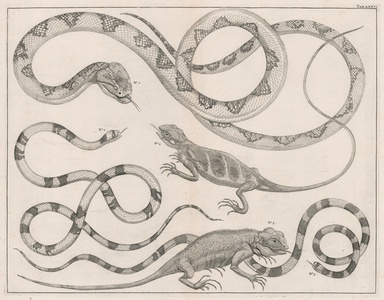| Method | Copper engraving |
| Artist | Albertus Seba |
| Published | [J. Wetsten, William Smith, Jansson-Waesberg et al., Amsterdam: 1734-1769] |
| Dimensions | Image 417 x 517 mm, Plate 425 x 547 mm, Sheet 475 x 596 mm |
| Notes |
A double page engraving of snakes and reptiles from Albert Seba's Locupletissimi Rerum Naturalium Thesauri Accurata Descriptio et Iconibus Artificiosissimis Expressio, Per Universam Physices Historiam. Based on Seba's extensive collections of exotic specimens of birds, reptiles, shells, butterflies, insects, mammals, and some fake specimens such as a seven headed hydra - no doubt to attract attention to the collection - Locupletissimi Rerum Naturalium Thesauri contains 449 plates over four volumes with plates engraved by Pierre Tanji, Adolf Van der Laan, F. de Bakker, A. van Buysen, de la Croix, J. Folkema, W. Jongman, F. Morellon, K.D. Ptter, J. Punt and J. van der Speyk. The plates are artistically arranged either showing groups of related specimens or unrelated specimens of plants and animals placed in aesthetic juxtaposition. Albertus Seba (1665–1736) moved to Amsterdam as an apprentice. In around 1700 he opened a pharmacy near the port, a strategic move, as it enabled him to ask sailors and ship surgeons to bring him exotic plants and animal products that he could use in his drug preparations. At around the same time, Seba also started to collect snakes, birds, insects, shells and lizards in his house. In early 1716 he sold his entire collection to Peter the Great, where it was later used to form the core of the Kunstkammer, the first Russian public museum. In October 1728 Seba became a Fellow of the Royal Society and some years later, in 1734, published a four-volume thesaurus of animal specimens with engraved illustrations based on his further amassed collections. Several years after his death his second collection went on auction in Amsterdam. A number of objects were purchased by the Petersburg Academy of Sciences. |
| Framing | unmounted |
| Price | £350.00 |
| Stock ID | 51748 |

